10 Tips for Learning a Foreign Language From YouTube Video
Read other articles:
Back to posts
Table of Contents
- 1 1.Learn from language tutor channels
- 2 2. Find movies and TV shows in your target language
- 3 3. Focus on videos about your favorite topics
- 4 4. Subscribe to polyglot channels
- 5 5.Turn on subtitles in the target language
- 6 6. If you can’t understand, slow it down
- 7 7. Use your target language in YouTube comments
- 8 8. Find videos with transcripts
- 9 9.Change the YouTube language to your target language
- 10 10. Search in your target language
- 11 An app to help you learn foreign language from YouTube…
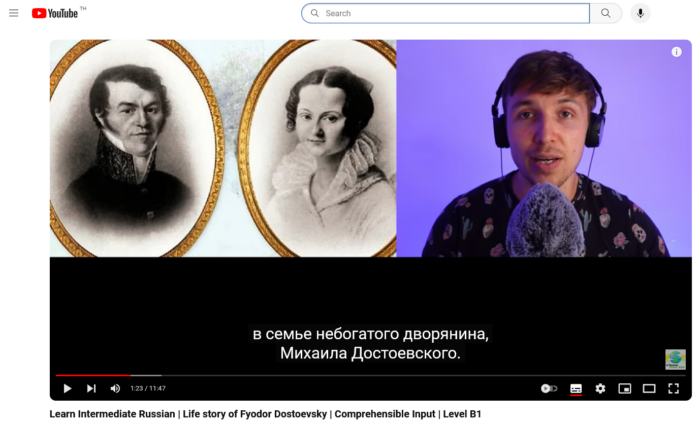
Immersing yourself in YouTube videos in your target foreign language can be a motivational, memorable, and meaningful way to learn a second language.
From learning through your favorite movies, TV shows, and vlogs to the channels of language tutors and polyglots, the huge library of videos available on the YouTube platform is a relatively untapped source of language-learning content for aspiring students.
Using both active and passive language learning techniques in a relaxed, engaging environment can produce great results for ambitious language learners who are aiming high for their proficiency.
The only problem is that with so much video content there, how do you know what you should be focusing on — and stop yourself being distracted by the rest?
Following are 10 tips for getting the most out of the learning experience on YouTube and an introduction to a simple Chrome extension that can assist you as you start out…
1.Learn from language tutor channels
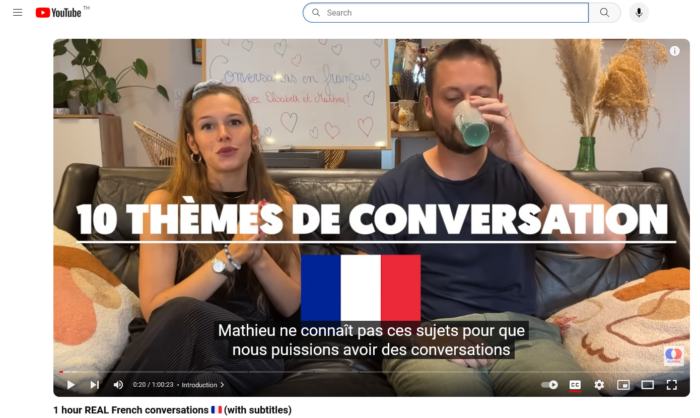
Many online language tutors have tapped into the huge demand for learning foreign languages online by setting up personal YouTube channels. This is an obvious place to start, especially for beginners.
Language lessons are normally free, as language tutors make money from YouTube with ads or by sending viewers to their paid online courses. Be wary of tutors who simply take you through vocab lists or present their videos in your native language rather than the target language.
Search for tutors who provide an engaging, immersive experience and conduct lessons entirely in the target language — that’s the most effective way to learn from video. Ideally, there are subtitles in the native language too, like in the above example from Learn French with Elisabeth.
Regardless of your target language, the “recommended” videos may not always be the best choices — check and do your homework on the best tutors and you can rapidly build a favorites list of 3-5 tutors.
2. Find movies and TV shows in your target language
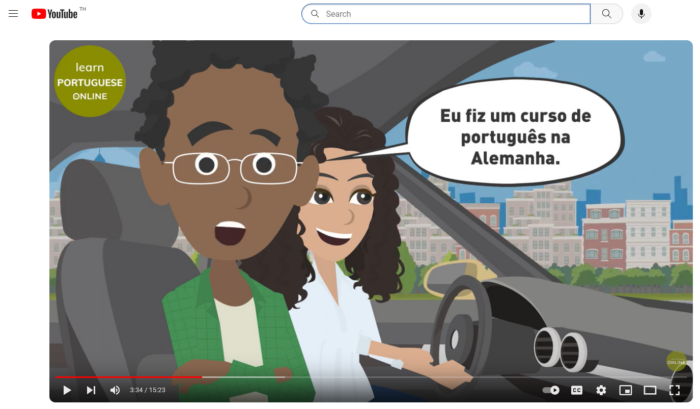
Unless you’re learning an obscure language from the eastern Kalahari desert, you should be able to find movies and TV shows in the target language (with subtitles in the target language too) without too much trouble on YouTube.
It doesn’t need to be blockbuster Hollywood movies. If you’re learning Brazilian Portuguese, for instance, you can watch the romantic novel Ana and Marcos on YouTube in the target language (see the above image).
Some passive learning may be possible if you simply watch the video for pleasure (which is OK) but repeat viewings with more active learning (pause and replay, noting new language, building a language library, etc.) will produce better learning results for ambitious students.
3. Focus on videos about your favorite topics
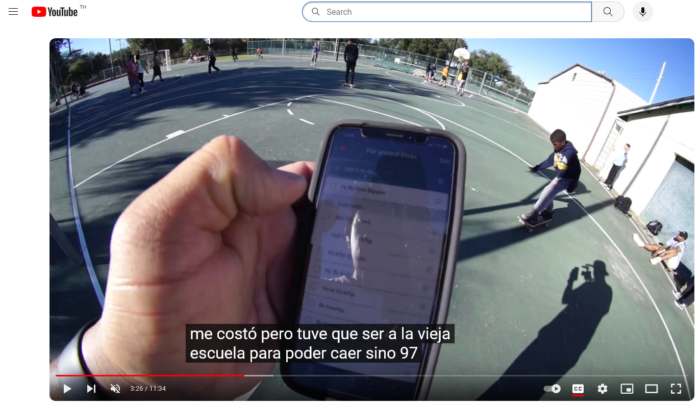
People learn best when they’re engaged with the topic. If you’re a keen skateboarder who happens to be learning Spanish, start following vloggers or TV programs on skateboarding in Spanish — like the above example from Toni Loves Skateboarding.
If you love skateboarding, you’ll pick up the Spanish language quicker (vocab, pronunciation, sentence structure, and rhythm) by watching videos like these because you’ll naturally pay more attention than you would with a video on crocheting or stamp collecting!
Whatever your interest is, translate it into your target language, enter it into the YouTube search bar, and see what it throws back at you. The number of niche topics that are out there in so many different foreign languages may surprise you.
4. Subscribe to polyglot channels
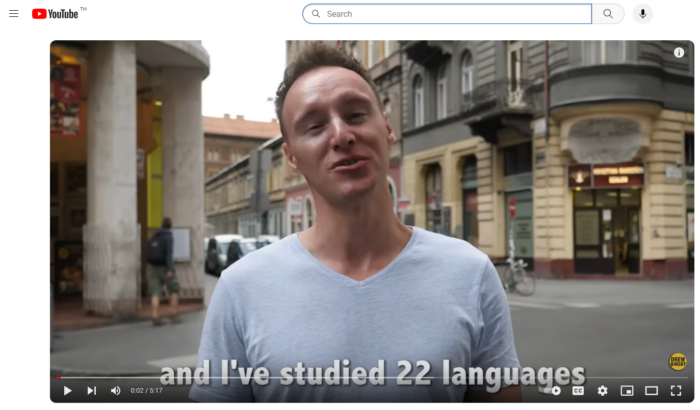
Polyglots are individuals who are proficient in multiple languages. This means that they know a thing or two about how to learn a language effectively. They’ve “hacked” the secrets and know what works and what doesn’t. Many are very creative with their methods, as you can see in this YouTube video by polyglot Lýdia Machová.
Many polyglots are aware of the demand to learn their secrets and have set up YouTube channels and presences on other online platforms to help other language learners. A couple of great examples include Lucas Lampariello and Steve Kaufmann.
5.Turn on subtitles in the target language

Resist the temptation to turn on subtitles in your native language as you’ll spend more time reading those than immersing yourself in the target language.
Clicking on the CC option in the bottom right of the video will switch subtitles on/off. Clicking on the Settings icon next to it will reveal your subtitle options (in the above example, it’s English or Italian).
Focus on videos that provide the option of turning on subtitles in the target language as this is proven to be the most effective learning method.
6. If you can’t understand, slow it down
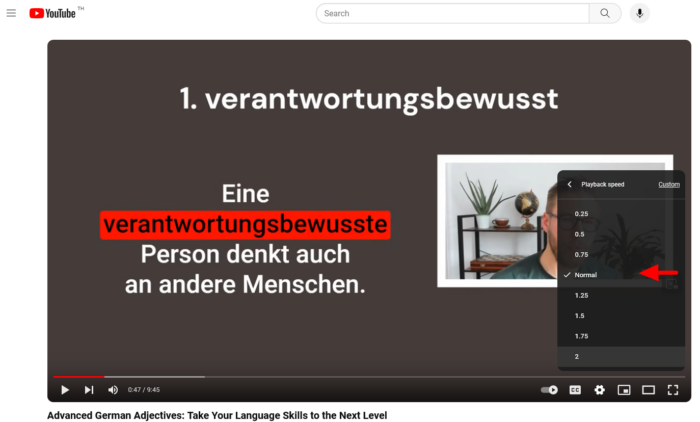
Sometimes, when watching YouTube videos in the target language, it can be challenging to hear the pronunciations of individual words, especially when two native speakers of the target language are in dialogue.
One neat trick is to slow the video down. Simply click the settings icon in the bottom right of the video, select Playback Speed, and then choose the speed at which you want to play the video.
“Normal” playback speed is recommended for general video watching as you’ll need to get used to the speed, flow, and rhythm of the language. However, for isolated cases of comprehension, slowing it down to 0.75 or even 0.5 can help.
Don’t forget to turn it back to “normal” afterward or all subsequent videos will play at the speed you’ve selected.
7. Use your target language in YouTube comments
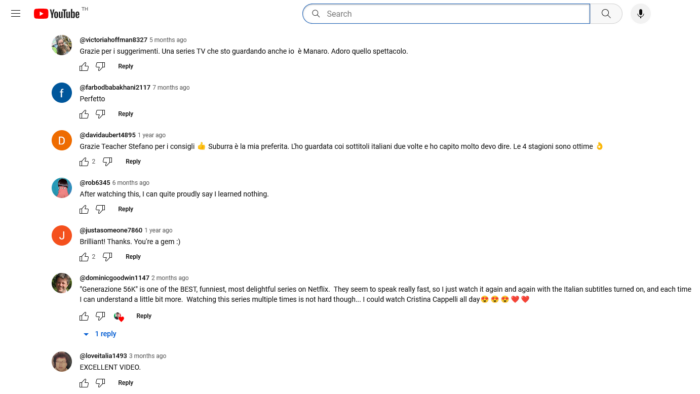
One of the beauties of learning a foreign language from YouTube is that you can “absorb” language naturally. The focus is on comprehensible input (listening and reading) rather than output (speaking and writing). One leading linguist (Stephen Krashen) stresses the importance of comprehensible input for effective language acquisition.
Don’t neglect the comments section below YouTube videos because speakers of your target language will likely comment.
This can make interesting reading but there may even be times when you want to interact with comments in the target language. Try to keep comments positive when you express an opinion and don’t worry if you get the language slightly wrong at times — someone may even correct you.
8. Find videos with transcripts
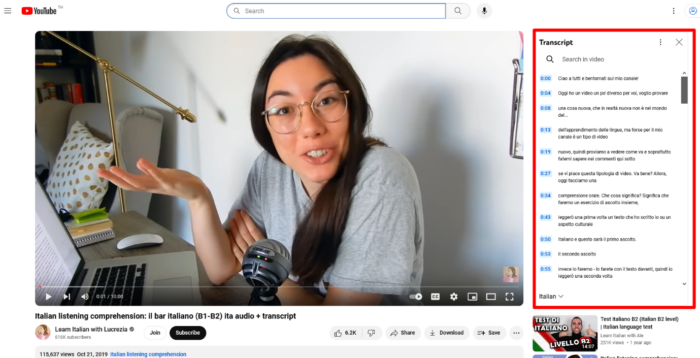
Some YouTube videos include transcripts of the audio from the video. With these types of videos, there is usually an option to show the transcript in the expandable video description just below the title of the video.
This can be useful for active learning if there are no subtitles and may aid comprehension, especially if the video is pitched well above your proficiency level in the language.
Clicking “Show Transcript” will reveal the transcript of the audio in the right-hand-side window of the screen, like in the example above.
9.Change the YouTube language to your target language

Learning Hungarian? How about changing your YouTube language to Magyar so that the entire experience when you log in is in your target language?
You can even change the location to Hungary for a more authentic native YouTube experience (different recommended videos may appear based on your location).
If you regularly receive email notifications from YouTube (for instance, for updates from channels you subscribe to), you can also specify the language you wish to receive these notifications in. Consider changing from your native language to your target language in your Account settings.
10. Search in your target language
When searching for suitable videos, how about searching in your target language rather than your native language to further edge you out of your “comfort zone”?
That will not only get you more used to writing/typing in your target language but it is also more likely to generate appropriate recommended videos from which you can learn from native speakers.
An app to help you learn foreign language from YouTube…
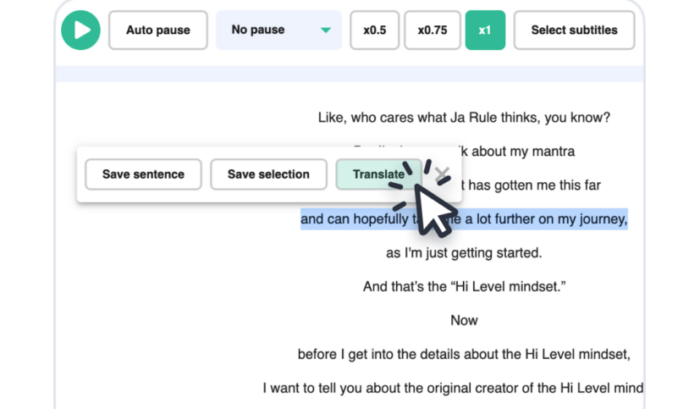
YouTube videos can provide genuine immersion into the language you’re learning. It’s the next best thing to being surrounded by native speakers. Soon, you’ll forget you’re online and learning from your living room, and be totally absorbed by the language you’re learning — as if you were there.
Some language-learning apps can boost the active learning experience while watching subtitled YouTube videos. Our free Chrome extension combines the best of AI with human learning to help you build a deeper understanding of your target language.
New language can be translated, explained, and saved to a personalized library. That means you can throw away your notebook and pen while creating a personalized language library in the cloud and developing greater language fluency.
Read other articles:
Back to posts
